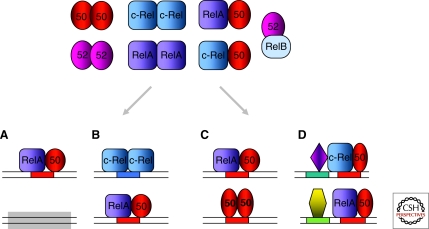Figure 1.
Mechanisms that contribute to the specificity of gene activation by NF-κB proteins. Homo- and heterodimerization between Rel-homology region (RHR) containing proteins generates a diverse range of κB sequence element binding proteins (top). Typically, several of these may be present in the cell nucleus after an activating stimulus, although the composition varies according to cell type, stimulus, and duration of signaling. The spectrum of genes activated is determined by several factors discussed in the text. (A) Tissue- or signal-specific marking may allow NF-κB binding to some genes (top) but not others (bottom). Gray box represents chromatin constraints that may preclude NF-κB binding. (B) The sequence of the κB element in promoters, represented by blue and red boxes, within DNA may bind specific RHR family proteins. (C) The same κB element (red box) may bind more than one RHR dimer under different circumstances, leading to different transcriptional outcomes. (D) The proximity of κB elements (red box) to other transcription factor binding sites (blue and green boxes) may differentially regulate gene expression by combinatorial mechanisms.

